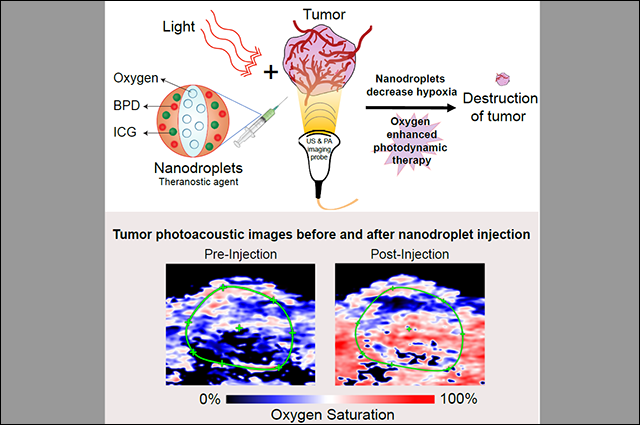Light-based cancer treatments

A team of researchers from the biomedical engineering lab of Tufts University Assistant Professor Srivalleesha Mallidi and from NanoHybrids Inc. utilized photoacoustic nanodroplets to deliver oxygen to hypoxic regions of tumors to enhance light-based cancer therapies. They detailed their work in a paper published in a recent edition of the journal Photoacoustics.
Hypoxia – oxygen deprivation at the tissue level – in solid tumors causes poor outcomes for a well-known cancer therapy called photodynamic therapy (PDT), which uses light to excite molecules that absorb light and convey that energy into nearby molecules, and creates reactive oxygen species (ROS) that can result in cell death or damage to cancerous tissue. With hypoxia strengthening resistance to treatment, the research team saw the need to minimize hypoxia while still sending enough molecules to the tumor to generate ROS.
The researchers studied unique theranostic perfluorocarbon nanodroplets, which can carry oxygen, photosensitizer molecules, and indocyanine green, which enables the delivery of light-triggered oxygen to tumors. In the study published in Photoacoustics, the team evaluated those photoacoustic nanodroplets and their ability to deliver oxygen to tumors in mouse models.
Overall, the group found that the nanodroplets can boost image-guided PDT. “This is a very useful technique, with clinically translatable components that we would like to extend to other chemo and radiation therapy as well,” said Mallidi.
Srivalleesha Mallidi is an assistant professor in the Department of Biomedical Engineering and directs the integrated Biofunctional and Therapeutics Laboratory (iBIT Lab) at Tufts University, which utilizes acoustic and optical imaging techniques with nanomaterials and biological models to understand the structural, functional, molecular, and biomechanical heterogeneity of pathologies such as cancer, as well as developing image-guided therapeutic strategies. Currently her lab has an opening for a research technician to work on the project – interested parties are invited to reach out to Professor Mallidi with a CV.
In addition to corresponding author Mallidi, authors on the paper include first author and PhD student Marvin Xavierselvan, undergraduate students Jeanne Duong, E23, and Nashielli Diaz, E22, and Jason Cook and Kimberly Homan of NanoHybrids Inc.
Department:
Biomedical Engineering